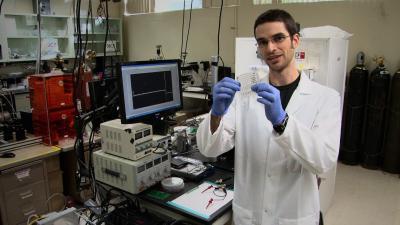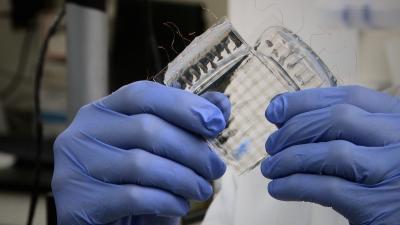When the nanotubes are airbrushed onto the silicone, they tend to land in randomly oriented little clumps. When the silicone is stretched, some of the "nano-bundles" get pulled into alignment in the direction of the stretching.
When the silicone is released, it rebounds back to its original dimensions, but the nanotubes buckle and form little nanostructures that look like springs.
"After we have done this kind of pre-stretching to the nanotubes, they behave like springs and can be stretched again and again, without any permanent change in shape," Bao said.
Stretching the nanotube-coated silicone a second time, in the direction perpendicular to the first direction, causes some of the other nanotube bundles to align in the second direction. That makes the sensor completely stretchable in all directions, with total rebounding afterward.
Additionally, after the initial stretching to produce the "nano-springs," repeated stretching below the length of the initial stretch does not change the electrical conductivity significantly, Bao said. Maintaining the same conductivity in both the stretched and unstretched forms is important because the sensors detect and measure the force being applied to them through these spring-like nanostructures, which serve as electrodes.
The sensors consist of two layers of the nanotube-coated silicone, oriented so that the coatings are face-to-face, with a layer of a more easily deformed type of silicone between them.
The middle layer of silicone stores electrical charge, much like a battery. When pressure is exerted on the sensor, the middle layer of silicone compresses, which alters the amount of electrical charge it can store. That change is detected by the two films of carbon nanotubes, which act like the positive and negative terminals on a typical automobile or flashlight battery.

Darren Lipomi, postdoctoral researcher in chemical engineering at Stanford University, holds up a piece of the super-stretchy, transparent, highly sensitive skin-like sensor that he helped develop in the lab of Zhenan Bao, associate professor of chemical engineering.(Photo Credit: Steve Fyffe, Stanford News Service)
The change sensed by the nanotube films is what enables the sensor to transmit what it is "feeling." Whether the sensor is being compressed or extended, the two nanofilms are brought closer together, which seems like it might make it difficult to detect which type of deformation is happening. But Lipomi said it should be possible to detect the difference by the pattern of pressure.
With compression, you would expect to see sort of a bull's-eye pattern, with the greatest deformation at the center and decreasing deformation as you go farther from the center.
"If the device was gripped by two opposing pincers and stretched, the greatest deformation would be along the straight line between the two pincers," Lipomi said. Deformation would decrease as you moved farther away from the line.
Bao's research group previously created a sensor so sensitive to pressure that it could detect pressures "well below the pressure exerted by a 20 milligram bluebottle fly carcass" that the researchers tested it with. This latest sensor is not quite that sensitive, she said, but that is because the researchers were focused on making it stretchable and transparent.
"We did not spend very much time trying to optimize the sensitivity aspect on this sensor," Bao said.
"But the previous concept can be applied here. We just need to make some modifications to the surface of the electrode so that we can have that same sensitivity."

A close-up view of the super-stretchy, transparent, highly sensitive skin-like sensor that Zhenan Bao, associate professor of chemical engineering, and Darren Lipomi, postdoctoral researcher in chemical engineering, developed at Stanford University with their colleagues.(Photo Credit: Steve Fyffe, Stanford News Service)
Source: Stanford University